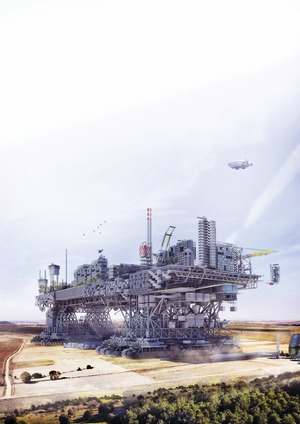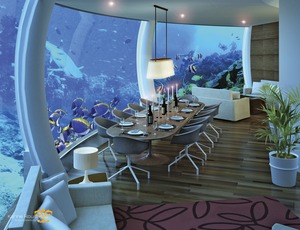

A London designer looking to transform polluted cities into enclosed environmental havens could have used the more proven geodesic dome as its technology. Instead, the firm is sticking to a still sketchy idea of an inflated-bubble approach supported by stressed cables—even without an owner or structural engineer on board—"because it's beautiful," says one of its architects.
 |
A project to build a record-setting bridge linking Italy and Sicily and a Chinese-led one to carve a canal through Nicaragua three times longer and 10 times costlier than the Panama Canal strain the limits of technical, economic and political reality. Yet these projects have persisted as dreams for decades, if not centuries, and still have supporters, if not very ardent proponents.
While some projects may remain fantasies on paper or in engineers' minds far into the future, if not indefinitely, others are inching closer to reality—helping their conceptors to perfect technology and project feasibility skills, and to better weigh benefits against emerging global impacts.
"Dreaming is a core part of the human condition," says Robert Prieto, senior vice president of Fluor Corp., who has written extensively on the management of very large projects.
"If you don't dream or conceive of what is possible, you can never improve or move the ball down field. In the 1960s, someone dreamed about creating a way to have computers move information among themselves, and it became the internet."
He adds: "The most compelling projects will make you uncomfortable, and everything we do is constrained. But in dreaming, you can find ways to overcome constraints."
Prieto and others say the Panama waterway, not to mention America's historic engineering marvels, such as the Erie Canal, transcontinental railroad and interstate highway system, all were once "aspirational."
In a recent speech to engineers in Panama, Major Gen. John Peabody, Army Corps of Engineers deputy commanding general for civil and emergency operations, quoted a passage on his late brother's computer: "A dream is just a dream. A goal is a dream with a plan and a schedule." He adds, "The practical issue is, can you get a return on investment and make a sea change in the way things operate in doing these projects?"
Peabody wonders if the Chinese backers of the Nicaraguan canal have done a traffic analysis to justify its $50-billion estimated cost. "China sees geopolitical advantage. 'We'll do a dream project because we can,' " he says.
Related Articles:
- Geo-engineering Has Fans and Foes as a Last-Resort Solution for Climate Change
- From the Minds of Science-Fiction Authors to the Desks of Design Firms: Sci-Fi Projects
Dreamworks-Chinese style
If there were no copyright issue with the Hollywood movie studio, "dreamworks" could well describe the government of Xi Jinpingin in China as it proposes grand schemes already tinged by grander controversies.
Huge projects are being announced and initiated almost every week since Xi became president in 2013. In fact, China's love for big projects is not a post- economic reform phenomenon.
Many ambitious projects built in the past decade or under construction—such as the Qinghai-Tibet railway, Three Gorges dam, the Tsangpo dam in the Himalayas and the south-north water diversion—date to the 1950s era of Mao Zedong, former chairman of China's Communist Party.
"In the case of Three Gorges, the need for power, movement of goods, flood control and greenhouse-gas reductions were seen as a reasonable trade-off ... for flooding towns and displacing millions of people," says sustainability consultant William A. Wallace, president of Wallace Futures Group. "Are those reasonable trade-offs? Many people didn't think so."
Truly dreamlike now is China's plan to convert land-locked Beijing into a port, connected to the sea via a 160-kilometer canal. The idea must weather rising resistance before the central government approves it, but observers say no plan may be too stupendous.
"China needs—more than it likes—these super-projects," He Weiwen, a senior researcher at Beijing's Renmin University, told ENR. But there is more to it than mere necessity. Projects are mostly implemented by giant state-owned firms with access to vast financial resources at low rates. Government policies are often reworked to suit project needs.
"Large projects save cost and help the process of capacity and expertise building," Zha Xiaogang, finance division director at the Shanghai Institutes for International Studies, told ENR. Shaofeng Jia, vice director of the Center for Water Resources Research at the Chinese Academy of Sciences, says the five-dam Tsangpo Himalayas project has had no foreign involvement.
Set for completion next year is the 632-meter-high Shanghai Tower, which will be the world's second-highest office building.
Also envisioned is the Silk Road and Maritime Silk Road program, an effort to connect 20, mostly Asian countries with road, rail and sea lanes. There also are plans to build the world's largest pumped-storage power station in north China's Hebei province, with an initial capacity of 3.6 gigawatts.
Spanish architecture grad student Manuel Domínguez borrowed engineering concepts used on oil platforms and rocket transporters to develop his "Star Wars"-like movable city on treads but admits that the 2012 idea is utopian and was an attempt at the time to best his university peers.



























